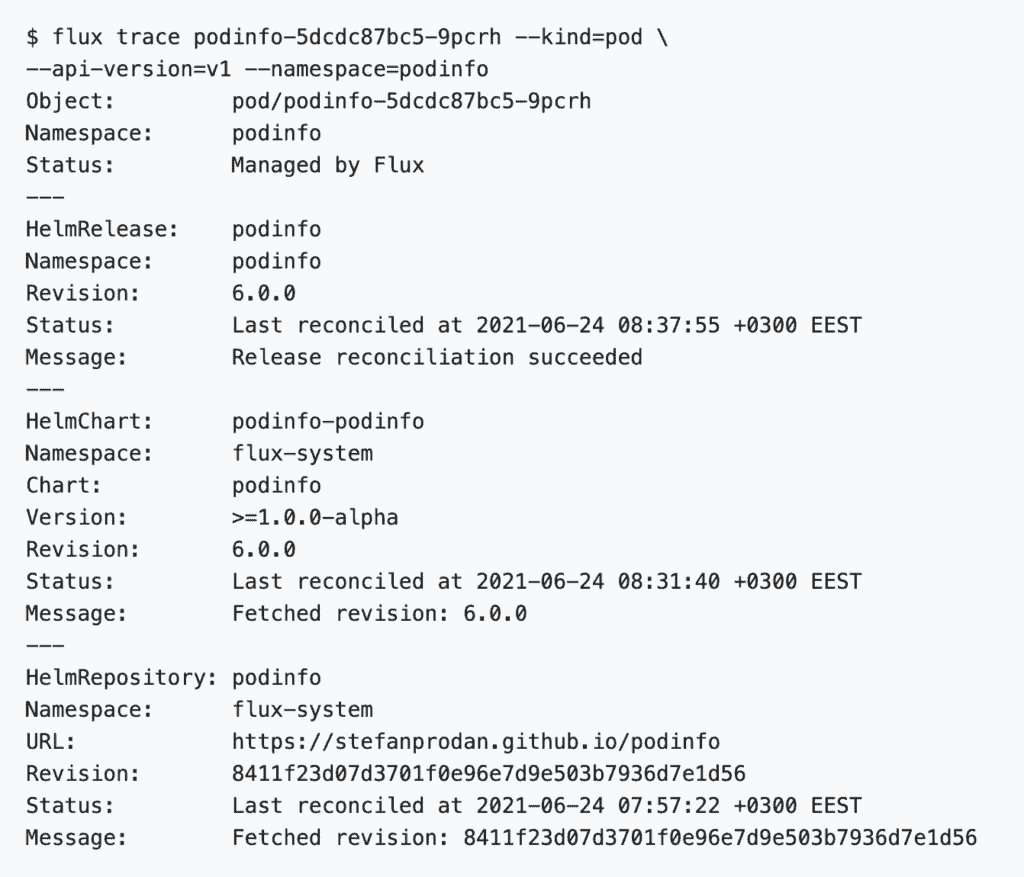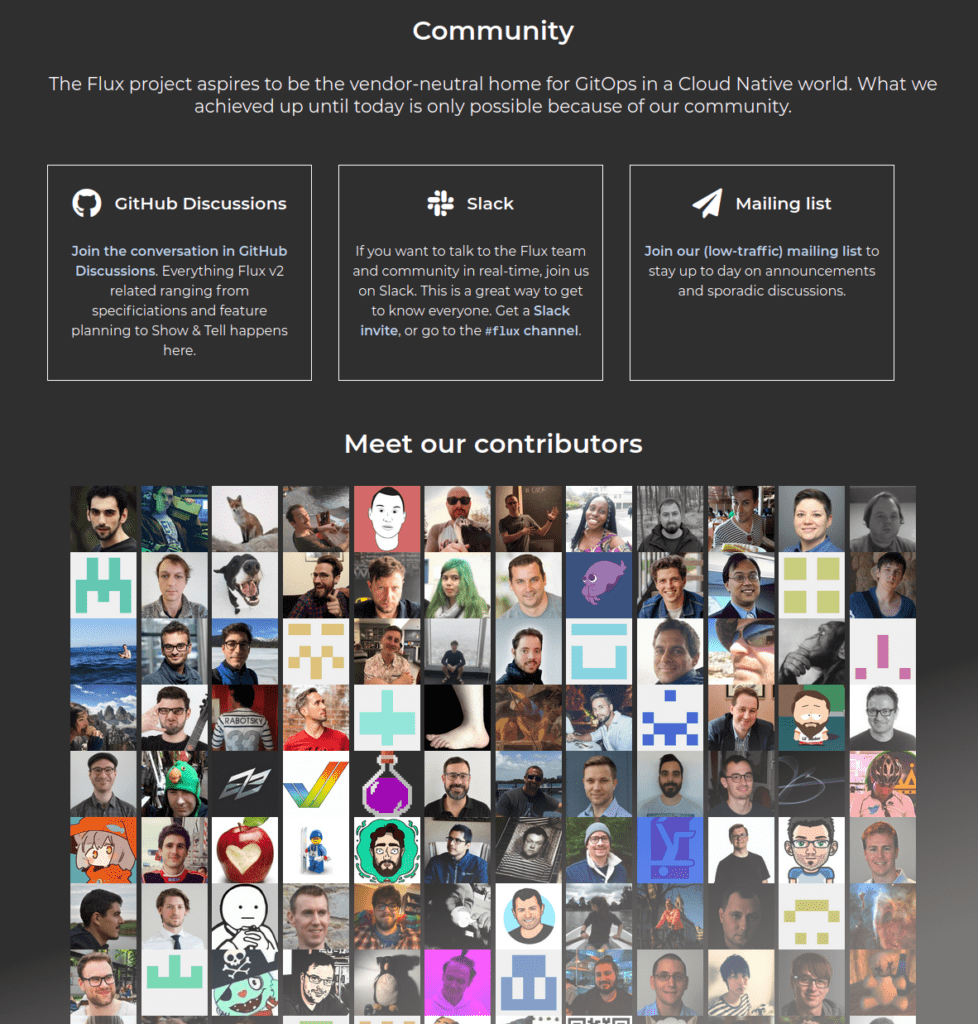Guest post originally published on Flux’s blog by Daniel Holbach
As the Flux family of projects and its communities are growing, we strive to inform you each month about what has already landed, new possibilities which are available for integration and where you can get involved. Read last month’s update here.
Let’s recap what happened in June – there has been so much happening!
From now on Flux APIs will be stable
We moved our APIs to v1beta1, which means that all Flux APIs are stable from now on. To us this means that Flux is production ready. You can make use of all these APIs, we’ll support them from now on. Going forward, breaking changes to the beta CRDs will be accompanied by a conversion mechanism.
Incidentally this also marks the 100th release in the fluxcd/flux2 repo. 🎆
How about you give us a ⭐ if you like it?
We are very proud of what we put together, here we want to reiterate some Flux facts – they are sort of our mission statement with Flux.
Flux Project Facts
- 🤼 Flux provides GitOps for both apps or infrastructure. With help from Flagger, Flux can automate the release process of apps using strategies like canaries and A/B rollouts. Flux can also manage any Kubernetes resource. Infrastructure and workload dependency management is built-in.
- 🤖 Just push to Git and Flux does the rest. Flux enables application deployment (CD) and progressive delivery (PD) through automatic reconciliation. Flux can update container image declarations in your YAML and push them automatically back to Git for you (based on new image tags discovered via scanning).
- 🔩 Flux plays nice with your existing tools: your Git providers (GitHub, GitLab, Bitbucket, can even use s3-compatible buckets as a source), all major container registries, and all CI workflow providers.
- ☸️ Flux works with any Kubernetes and all common Kubernetes tooling: Kustomize, Helm, RBAC, and policy-driven validation (OPA, Kyverno, admission controllers) so it simply falls into place.
- 🤹 Flux does Multi-Tenancy (and “Multi-everything”): Flux uses true Kubernetes RBAC via impersonation and supports multiple Git repositories. Multi-cluster infrastructure and apps work out of the box with Cluster API: Flux can use one Kubernetes cluster to manage apps in either the same or other clusters, spin up additional clusters themselves, and manage clusters including lifecycle and fleets.
- 📞 Flux alerts and notifies: Flux provides health assessments, alerting to external systems and external events handling. Just “git push”, and get notified on Slack and other chat systems.
- 💖 Flux has a lovely community that is very easy to work with! We welcome contributors of any kind. The components of Flux are on Kubernetes core controller-runtime, so anyone can contribute and its functionality can be extended very easily.
New releases in the Flux family
Flux 0.16 hits the streets
We’ve released flux2 v0.16.0. Starting with this version, all Flux APIs are considered stable and ready for production use. ✨
The highlights are:
- 🚀 The image automation APIs have been promoted from v1alpha2 to v1beta1. There are no breaking changes; to upgrade from
image.toolkit.fluxcd.io/v1alpha2, simply change the API version to v1beta1 for all the image manifests in Git. - 🦾 Flux has full support for mixed-arch Kubernetes clusters. We now run the conformance test suite for Flux pre-releases on both AMD64 and ARM64.
- 🔎 New
flux tracecommand that allows Flux users to point the CLI to a Kubernetes object in-cluster and get a detailed report about the GitOps pipeline that manages that particular object.

📔 Check out the Flux roadmap updates https://fluxcd.io/docs/roadmap/.
⚠ Breaking Changes in 0.15
In this version, Flux and its controllers have been upgraded to Kustomize v4. While Kustomize v4 comes with many improvements and bug fixes, it introduces a couple of breaking changes:
- YAML anchors are no longer supported in Kustomize v4, see kustomize/issues/3675 for more details.
- Due to the removal of
hashicorp/go-getterfrom Kustomize v4, the set of URLs accepted by Kustomize in the resources filed is reduced to file system paths, URLs to plain YAMLs and values compatible with git clone. This means you can no longer use resources from archives (zip, tgz, etc). - Due to a bug in Kustomize v4, if you have non-string keys in your manifests, the controller will fail with json: unsupported type error.
More details on breaking changes can be found at #1522
Flagger 1.12 got released
1.12.1: This release comes with a fix to Flagger when used with Flux v2.
- Improvements: Update Go to v1.16 and Kubernetes packages to v1.21.1 #940
- Fixes: Remove the GitOps Toolkit metadata from generated objects #939
1.12.0: This release comes with support for disabling the SSL certificate verification for the Prometheus and Graphite metric providers.
- Improvements:
- Fixes: Require SMI TrafficSplit Service and Weight #878
Upcoming events
It’s important to us to keep you up to date with new features and developments in Flux and provide simple ways to see our work in action and chat with our engineers.
The Bug Scrub
Kingdon Barrett organised our first ever Bug Scrub. To quote from the announcement:
For us, a great way to get started, is to learn more about Flux through direct experience, when e.g. trying to reproduce issues reported by other Flux users, and the general business of chopping wood and carrying water. The Flux Bug Scrub is born.
The inaugural first Bug Scrub event commenced and concluded on June 30. It was a great success where we collectively as a team visited 53 issues in about 60 minutes. This was a terrific opportunity which we will be repeating on a regular weekly basis for the time being.
Kingdon will continue hosting these hour-long gatherings on a staggered weekly basis, in the empty time slot which is opposite the existing “CNCF Flux Project Meeting” community meeting; the next Bug Scrub is on July 8 at 8:00 Pacific / 11:00 Eastern Time / 15:00 UTC, (and from now on you can find them on the CNCF Flux calendar.) Volunteers at any skill level are welcome to attend, come spend an hour levelling up your Flux knowledge by reviewing open issues with the team.
Watch this space and our social channels for news and more details about these events as they happen. Also reach out to Kingdon if you want to get involved in any bug scrubbing.
Apart from that, there’s also https://fluxcd.io/community/#talks for more links to recordings of past talks.
In other news
People writing about Flux
(Typical) journey towards full GitOps
This is a new section where we want to highlight people who talk and write about Flux. If you have an article you would like us to refer to, hit us up on Slack or Twitter or Email. We’re looking forward to giving you a shout-out!
Alexander Holbreich wrote a very nice article called “ (Typical) journey towards full GitOps”.

It’s well-written, easy to read and goes into enough detail for newcomers to understand it. Thanks Alexander for this write-up!
Flux at the Okteto Community Call
https://okteto.com/blog/june-2021-community-call-recap/
One of the Flux maintainers, @kingdonb, was invited on the Okteto community call for show-and-tell about how Flux and Okteto integration works; the video link is in the blog post which is featured on the Okteto blog at the link above. See how the Okteto CLI can be used to invoke a debugger inside a pod running on your dev cluster, which together with VS Code shortens the inner loop of development, providing a unique developer experience with Flux.
Website and Docs news
Our web and docs team has been busy as well.
🤹 First of all we would like to congratulate everyone who added themselves to the Flux Adopters page. It’s beautiful for all of us who work on the Flux to see how our projects are used in the wild.
📔 We moved our legacy documentation (Flux Legacy and Helm Operator) from docs.fluxcd.io to fluxcd.io/legacy and replaced all old docs with redirects. This was done because our docs were hosted on two different pieces of infrastructure and came from different repositories. They were hard to update and some of our users got confused about which docs they were looking at. If you have any feedback about this, let us know.
🔋 We also just added a Flux Integrations page. If your extension or integration is not listed yet, please add yourself. We will make this page shine more in the future – we are also happy to work on joint blog posts, etc. Just come and talk to us!
💖 Our landing page received a number of style updates and now shows Flux contributors! It’s great to be able to see everyone who is making this happen.

Many docs have received updates and more information and we are pleased that many new docs PRs have been coming in from new contributors! We now check links automatically as well.
Over and out
If you like what you read and would like to get involved, here are a few good ways to do that:
- Join our upcoming dev meetings on 2021-07-01 15:00 UTC, or 2021-07-07, 12:00 UTC.
- Talk to us in the #flux channel on CNCF Slack
- Join the planning discussions
- And if you are completely new to Flux v2, take a look at our Get Started guide and give us feedback
- Social media: Follow Flux on Twitter, join the discussion in the Flux LinkedIn group.
We are looking forward to working with you.